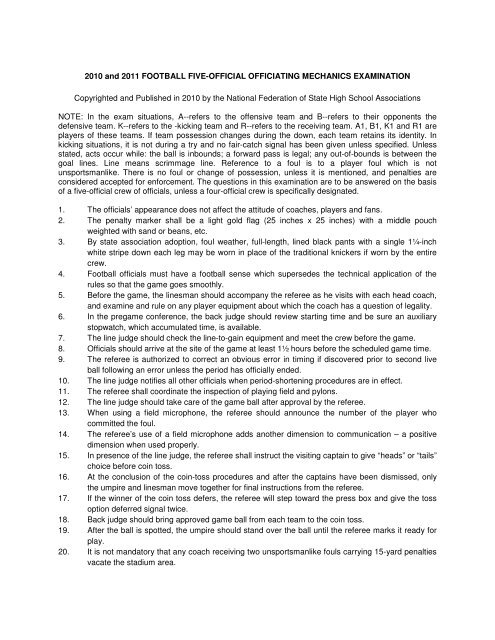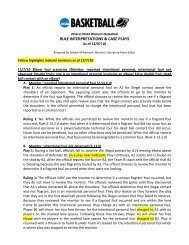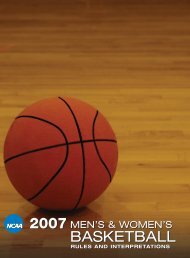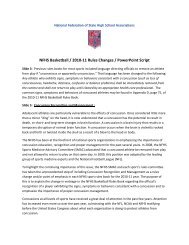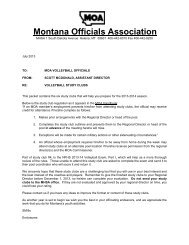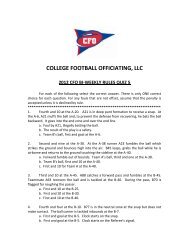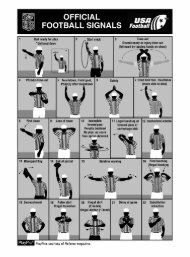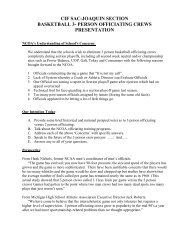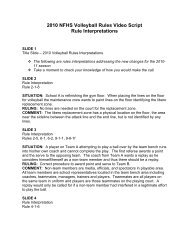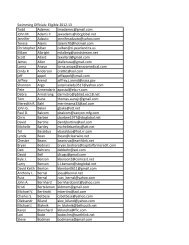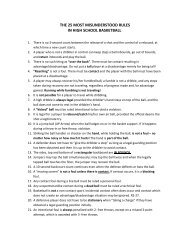Montana Officials Association - MOA - ArbiterSports
Montana Officials Association - MOA - ArbiterSports
Montana Officials Association - MOA - ArbiterSports
Create successful ePaper yourself
Turn your PDF publications into a flip-book with our unique Google optimized e-Paper software.
2010 and 2011 FOOTBALL FIVE-OFFICIAL OFFICIATING MECHANICS EXAMINATIONCopyrighted and Published in 2010 by the National Federation of State High School <strong>Association</strong>sNOTE: In the exam situations, A--refers to the offensive team and B--refers to their opponents thedefensive team. K--refers to the -kicking team and R--refers to the receiving team. A1, B1, K1 and R1 areplayers of these teams. If team possession changes during the down, each team retains its identity. Inkicking situations, it is not during a try and no fair-catch signal has been given unless specified. Unlessstated, acts occur while: the ball is inbounds; a forward pass is legal; any out-of-bounds is between thegoal lines. Line means scrimmage line. Reference to a foul is to a player foul which is notunsportsmanlike. There is no foul or change of possession, unless it is mentioned, and penalties areconsidered accepted for enforcement. The questions in this examination are to be answered on the basisof a five-official crew of officials, unless a four-official crew is specifically designated.1. The officials’ appearance does not affect the attitude of coaches, players and fans.2. The penalty marker shall be a light gold flag (25 inches x 25 inches) with a middle pouchweighted with sand or beans, etc.3. By state association adoption, foul weather, full-length, lined black pants with a single 1¼-inchwhite stripe down each leg may be worn in place of the traditional knickers if worn by the entirecrew.4. Football officials must have a football sense which supersedes the technical application of therules so that the game goes smoothly.5. Before the game, the linesman should accompany the referee as he visits with each head coach,and examine and rule on any player equipment about which the coach has a question of legality.6. In the pregame conference, the back judge should review starting time and be sure an auxiliarystopwatch, which accumulated time, is available.7. The line judge should check the line-to-gain equipment and meet the crew before the game.8. <strong>Officials</strong> should arrive at the site of the game at least 1½ hours before the scheduled game time.9. The referee is authorized to correct an obvious error in timing if discovered prior to second liveball following an error unless the period has officially ended.10. The line judge notifies all other officials when period-shortening procedures are in effect.11. The referee shall coordinate the inspection of playing field and pylons.12. The line judge should take care of the game ball after approval by the referee.13. When using a field microphone, the referee should announce the number of the player whocommitted the foul.14. The referee’s use of a field microphone adds another dimension to communication – a positivedimension when used properly.15. In presence of the line judge, the referee shall instruct the visiting captain to give “heads” or “tails”choice before coin toss.16. At the conclusion of the coin-toss procedures and after the captains have been dismissed, onlythe umpire and linesman move together for final instructions from the referee.17. If the winner of the coin toss defers, the referee will step toward the press box and give the tossoption deferred signal twice.18. Back judge should bring approved game ball from each team to the coin toss.19. After the ball is spotted, the umpire should stand over the ball until the referee marks it ready forplay.20. It is not mandatory that any coach receiving two unsportsmanlike fouls carrying 15-yard penaltiesvacate the stadium area.


